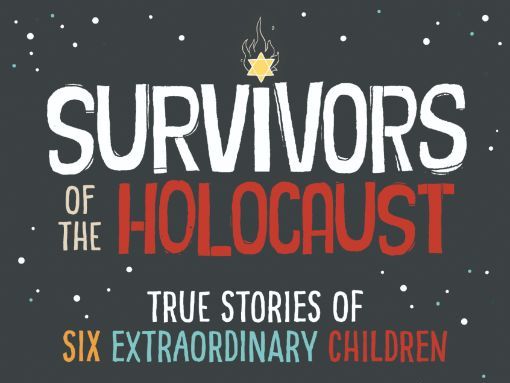Survivors of the Holocaust: True Stories of Six Extraordinary Children, edited by Keith Shackleton, illustrated by Zane Whittingham; Sourcebooks, © 2019; ISBN pending, 96 pages.
This set of six memoirs, illustrated cartoon style, is intended to make the Holocaust accessible to children ages 10 and up. Today living in Leeds, England, the six survivors narrate what happened to them before and during World War II. In all the stories, Nazis are illustrated as scary wolf-like people, which may well be how they appeared to the children who were their victims.
Three of the survivors had lived in Germany prior to the war, one in France, and one in Czechoslovakia. A sixth survivor, who had suffered extensively in Auschwitz, did not mention where he grew up – perhaps to universalize the experience of barely surviving in a death camp.
Heinz Skyte narrated how Nazis placed more and more restrictions on the Jews of Germany, how arrests were frequent, and how synagogues were burned down during Kristallnacht. He was able to join his brother in Leeds, England, before Germany and England were at war. Even though nobody wanted to defeat the Nazis more than the Jews, those from Germany were imprisoned in England as “enemy aliens.”
Trude Silman told of being sent by her parents to safety in England, and never seeing them again. She told how agonizing it was to be away from her parents, and how frustrating it was to be in a country where she did not understand the language.
Ruth Rogoff left Eastern Germany for Prague, Czechoslovakia, but it wasn’t long before the German Nazis took over that country. Her mother went from embassy to embassy trying to get visas for their family. Finally, the British agreed to let the family come. On the day that they arrived, England declared war on Germany following the Nazis’ invasion of Poland.
Martin Kapel was deported with other Polish Jews from Germany back to Poland. The group in which he was in was forced to march along a railroad track through a tunnel to the Polish border, where initially the Poles refused to take them. In Poland, Kapel was chosen for a kindertransport that would give him a new life in England. He was sent to the town of Coventry, and had to endure massive aerial bombing attacks by the Nazis.
Suzanne Ripton was a preschooler when the Nazis arrested her parents. A neighbor woman, who was not Jewish, said the girl was her daughter, and in that way rescued her. They then went to the countryside to live in primitive conditions until 1947, when they learned that the war had ended two years before. Eventually the Red Cross sent Suzanne to Newcastle, England, to be reunited with her grandmother.
Arek Hersh, who survived Auschwitz, related that when he disembarked from a train that had taken him to Auschwitz, he violated the order to stand in the left line with the children, and elderly, and instead went to the right line, where men who looked fit were standing. As the left line led directly to the gas chambers, he thereby saved his life. Afterwards, he was stripped, relieved of all his possessions, issued a prison uniform, assigned to a bunk with nine other people, was tattooed, suffered from lack of sanitation, sleep, and food, yet somehow managed to stay alive, and was liberated.
In an epilogue we learned that the six survivors all went on to successful lives in England. Heinz headed a housing organization; Trude became a medical biochemist; Ruth taught secondary school; Martin lectured about science at a university; Suzanne, a homemaker, testified about her neighbor the rescuer, resulting in that woman being honored at Yad Vashem as a Righteous Gentile; and Arek wrote books, and sometimes guided people through Auschwitz.
The narratives and drawings no doubt will raise many questions in the minds of children. If this is to be used in the schools, it would be good if the children’s teachers are trained to answer those questions.
Republished from San Diego Jewish World


























